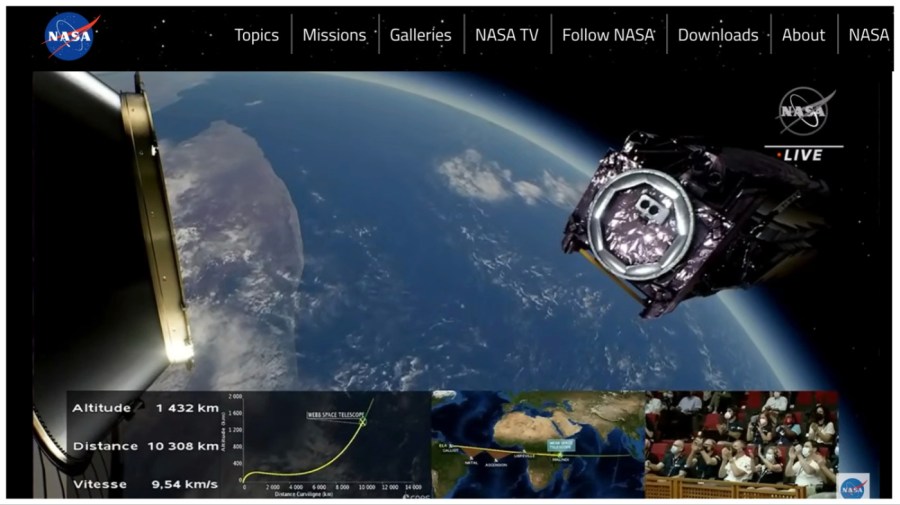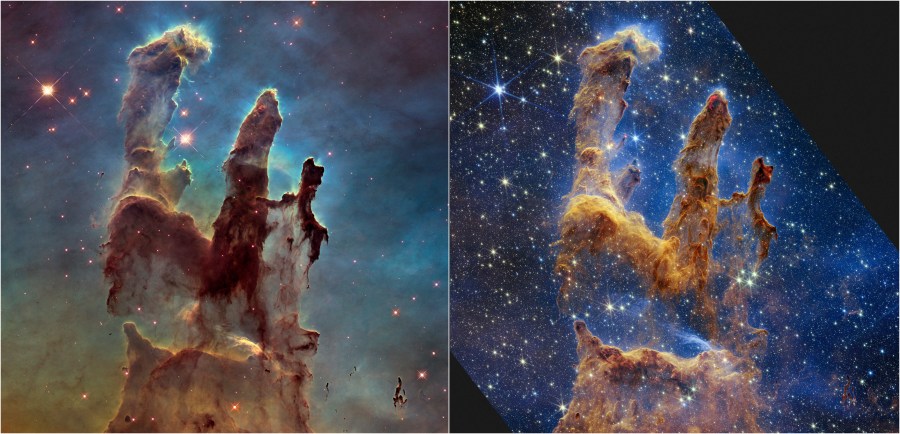Webb telescope images provide milestone in research of distant galaxies

NASA has released an image of Rho Ophiuchi, the closest star-forming region to Earth, that is providing new insights into the formation of stars.
The images comes from NASA’s James Webb Space Telescope (JWST), which has been observing the cosmos for one year. NASA released the image of Rho Ophiuch to mark the milestone.
“The JWST’s image of Rho Ophiuchi allows us to witness a very brief period in the stellar life cycle with new clarity,” says Klaus Pontoppidan, a JWST project scientist at the Space Telescope Science Institute (STSI) in Baltimore. “Our own sun experienced a phase like this long ago, and now we have the technology to see the beginning of another star’s story.”
Stars are formed in the stellar nursery from the rich supply of gas and dust. The image depicts a chaotic cosmic close-up of the region like none previously seen.
Underneath the seemingly peaceful facade, lies the origin story of stars that are similar to our own.
Within the new image, glowing regions of hydrogen gas are shown in red, and represent the newly forming stars breaking free of the cosmic cocoon they formed in, much like a butterfly breaking free from its chrysalis.
Although most of the stars in this region will be roughly the size of the Sun or a bit smaller, there is one massive star lurking in the lower portion of the image. The bright blue star, S1, has carved out a bit of dust in the glowing yellow material surrounding it. Also visible are protostars (stars that are in the process of forming), which are located in the darkest regions of the photo.
NASA’s Administrator, former Sen. Bill Nelson (D-Fla.), says that this image is the perfect one to represent Webb’s first year of science operations.
“In just one year, the James Webb Space Telescope has transformed humanity’s view of the cosmos, peering into dust clouds and seeing the light from faraway corners of the universe for the very first time,” he said. “Every new image is a new discovery, empowering scientists around the globe to ask and answer questions they could never dream of.”

The James Webb Space Telescope being released into space from an Ariane rocket on Saturday, Dec. 25, 2021. (NASA via AP, File)
Webb launched in December 2021, and at the time, the massive space telescope was massively delayed and over budget. Supporters of the telescope say the new images show the worth of the investment in the project.
One year ago, NASA released the very first image taken by Webb – a deep field image, which is similar to a long-exposure photograph. These types of images help to resolve the faintest objects in the universe. As such, they are essentially a look back in time, a snapshot of what the universe looked like billions of years ago. Deep field images like this are chock full of galaxies. In fact, almost every point of light in the image is a galaxy.
In 1995, NASA’s Hubble Space Telescope took stunning deep field image that captured roughly 3,000 galaxies in various stages of evolution.
The new image from Webb takes things to a new level.
It focuses on a galaxy cluster called SMACS 0723, where thousands of galaxies may be observed. Thanks to the collective mass of this cluster, which acts like a gravitational lens or magnifying glass, more distant galaxies can be seen than before – some even from a time period when the universe was less than a billion years old.
And some of these galaxies have surprising qualities, such as unexpectedly large size or higher rates of star formation than researchers would have expected.
Webb captures some of the faintest objects ever observed. Thanks to Webb’s increased capabilities, scientists were also able to reduce the time it takes to make observations. For instance, this deep field image took 12.5 hours of observation time, versus the weeks of time it took Hubble to snap a similar image.
Webb is also able to bring more distant objects into sharper focus. In its deep field image, within distant galaxies, the telescope has been able to focus on tiny, faint structures that have never been seen before. These include star clusters and diffuse features.

This combination image provided by NASA shows the Pillars of Creation as imaged by NASA’s Hubble Space Telescope in 2014, left, and by NASA’s James Webb Telescope, right. (NASA, ESA, CSA, STScI via AP)
Webb has also provided new insight into black holes.
One of the observatory’s more recent observations include the most distant supermassive black hole. The black hole CEERS 1019, is a bit of an enigma. It weighs approximately 9 million solar masses, which is quite light for black hole standards, which typically “weigh” in at 1 billion times the mass of the Sun. For comparison, the black hole at the center of our galaxy, Sagittarius A*, is about 4.6 million times the mass of the Sun.
A typical black hole can be found at the center of a galaxy and tends to be a very bright object. The light comes from material surrounding the black hole as it falls into it. CEERS 1019 is surprisingly dark for such an old black hole – the majority of other black holes observed dating back to this time period are much brighter.
Researchers are hoping that with Webb’s help they can learn more about the enigmatic cosmic objects and help improve how they classify them and how different types of black holes evolve over time.
According to Rebecca Larson, a research scientist at the University of Texas at Austin, data collected by Webb is teeming with precise information about this particular black hole, and her team is hopeful that they can pinpoint how much material the black hole is consuming and how that affects its host galaxy’s star formation rate.
“The breadth of science Webb is capable of exploring really becomes clear now, when we have a full year’s worth of data from various targets across the sky,” says Eric Smith, associate director for research in the Astrophysics Division at NASA Headquarters and a Webb program scientist.
“Webb’s first year of science has not only taught us new things about our universe, but it has revealed the capabilities of the telescope to be greater than our expectations, meaning future discoveries will be even more amazing.”
Copyright 2023 Nexstar Media Inc. All rights reserved. This material may not be published, broadcast, rewritten, or redistributed. Regular the hill posts







